A Visual Reference to Ancient Egyptian Art From Today
The artworks of aboriginal Arab republic of egypt have fascinated people for thousands of years. The early on Greek and later Roman artists were influenced by Egyptian techniques and their art would inspire those of other cultures upwards to the present day. Many artists are known from later periods but those of Egypt are completely anonymous and for a very interesting reason: their fine art was functional and created for a practical purpose whereas later art was intended for artful pleasance. Functional art is work-made-for-hire, belonging to the private who commissioned it, while art created for pleasance - fifty-fifty if deputed - allows for greater expression of the artist's vision so recognition of an individual artist.
A Greek artist like Phidias (c. 490-430 BCE) certainly understood the practical purposes in creating a statue of Athena or Zeus but his primary aim would accept been to make a visually pleasing piece, to make 'art' as people empathise that discussion today, not to create a applied and functional piece of work. All Egyptian art served a practical purpose: a statue held the spirit of the god or the deceased; a tomb painting showed scenes from 1's life on earth so 1'due south spirit could remember it or scenes from the paradise one hoped to attain and so one would know how to become at that place; charms and amulets protected i from impairment; figurines warded off evil spirits and angry ghosts; mitt mirrors, whip-handles, cosmetic cabinets all served applied purposes and ceramics were used for drinking, eating, and storage. Egyptologist Gay Robins notes:
As far as we know, the ancient Egyptians had no word that corresponded exactly to our abstract utilise of the word 'art'. They had words for private types of monuments that nosotros today regard as examples of Egyptian art - 'statue', 'stela', 'tomb' -but there is no reason to believe that these words necessarily included an aesthetic dimension in their pregnant. (12)
"fine art for art'due south sake" was unknown & would have probably been incomprehensible to an aboriginal Egyptian who understood fine art as functional above all else.
Although Egyptian art is highly regarded today and continues to be a great draw for museums featuring exhibits, the ancient Egyptians themselves would never have thought of their work in this same manner and certainly would find it strange to accept these different types of works displayed out of context in a museum'southward hall. Statuary was created and placed for a specific reason and the same is true for any other kind of art. The concept of "art for art's sake" was unknown and, farther, would have probably been incomprehensible to an ancient Egyptian who understood art equally functional to a higher place all else.
Egyptian Symmetry
This is not to say the Egyptians had no sense of aesthetic dazzler. Fifty-fifty Egyptian hieroglyphics were written with aesthetics in mind. A hieroglyphic sentence could be written left to right or right to left, upward to down or down to upwardly, depending entirely on how i'south choice affected the beauty of the finished piece of work. Simply put, any work needed to be cute but the motivation to create was focused on a practical goal: function. All the same, Egyptian fine art is consistently admired for its beauty and this is considering of the value ancient Egyptians placed on symmetry.
The perfect rest in Egyptian fine art reflects the cultural value of ma'at (harmony) which was central to the civilization. Ma'at was not but universal and social gild but the very fabric of creation which came into being when the gods made the ordered universe out of undifferentiated chaos. The concept of unity, of oneness, was this 'chaos' but the gods introduced duality - night and day, female person and male, dark and light - and this duality was regulated by ma'at.
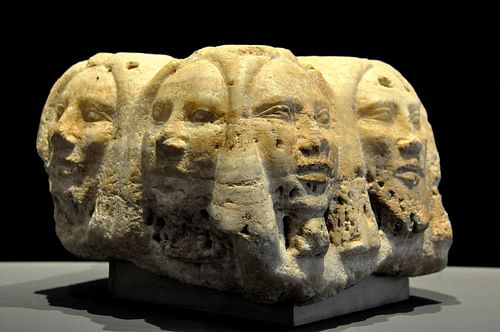
Proto-Historical Statue from Arab republic of egypt
It is for this reason that Egyptian temples, palaces, homes and gardens, statuary and paintings, signet rings and amulets were all created with residuum in heed and all reverberate the value of symmetry. The Egyptians believed their state had been made in the epitome of the world of the gods, and when someone died, they went to a paradise they would observe quite familiar. When an Egyptian obelisk was made it was always created and raised with an identical twin and these two obelisks were thought to have divine reflections, made at the aforementioned time, in the land of the gods. Temple courtyards were purposefully laid out to reflect creation, ma'at, heka (magic), and the afterlife with the aforementioned perfect symmetry the gods had initiated at cosmos. Art reflected the perfection of the gods while, at the same time, serving a practical purpose on a daily basis.
Historical Progression
The art of Egypt is the story of the elite, the ruling class. Throughout most of Arab republic of egypt'due south historical periods those of more modest means could non afford the luxury of artworks to tell their story and information technology is largely through Egyptian art that the history of the civilisation has come to be known. The tombs, tomb paintings, inscriptions, temples, even most of the literature, is concerned with the lives of the upper class and only by mode of telling these stories are those of the lower classes revealed. This paradigm was already set prior to the written history of the civilisation. Fine art begins in the Predynastic Menstruation in Arab republic of egypt (c. 6000 - c. 3150 BCE) through stone drawings and ceramics only is fully realized by the Early Dynastic Flow (c. 3150 - c. 2613 BCE) in the famous Narmer Palette.
The Narmer Palette (c. 3150 BCE) is a two-sided ceremonial plate of siltstone intricately carved with scenes of the unification of Upper and Lower Egypt by King Narmer. The importance of symmetry is evident in the composition which features the heads of four bulls (a symbol of ability) at the top of each side and balanced representation of the figures which tell the story. The work is considered a masterpiece of Early Dynastic Period fine art and shows how advanced Egyptian artists were at the time.
![Narmer Palette [Two Sides]](https://www.worldhistory.org/img/r/p/500x600/4412.jpg?v=1649972822)
Narmer Palette [Two Sides]
The later piece of work of the architect Imhotep (c. 2667-2600 BCE) on the pyramid of King Djoser (c. 2670 BCE) reflects how far artworks had avant-garde since the Narmer Palette. Djoser'due south pyramid circuitous is intricately designed with lotus flowers, papyrus plants, and djed symbols in high and low relief and the pyramid itself, of course, is evidence of the Egyptian skill in working in stone on monumental artworks.
During the Old Kingdom of Egypt (c. 2613-2181 BCE) fine art became standardized by the elite and figures were produced uniformly to reflect the tastes of the capital at Memphis. Bronze of the late Early Dynastic and early One-time Kingdom periods is remarkably like although other fine art forms (painting and writing) show more sophistication in the Quondam Kingdom. The greatest artworks of the Old Kingdom are the Pyramids and Great Sphinx of Giza which however stand today but more pocket-sized monuments were created with the same precision and beauty. Old Kingdom art and architecture, in fact, was highly valued by Egyptians in later eras. Some rulers and nobles (such equally Khaemweset, 4th son of Ramesses Two) purposefully commissioned works in Sometime Kingdom fashion, fifty-fifty the eternal home of their tombs.
In the Commencement Intermediate Period of Arab republic of egypt (2181 -2040 BCE), following the plummet of the Old Kingdom, artists were able to express individual and regional visions more freely. The lack of a potent central government commissioning works meant that commune governors could requisition pieces reflecting their dwelling province. These unlike districts also establish they had more dispensable income since they were not sending equally much to Memphis. More than economic power locally inspired more than artists to produce works in their own style. Mass production began during the First Intermediate Menstruation as well and this led to a uniformity in a given region'southward artwork which made information technology at once distinctive simply of lesser quality than Old Kingdom piece of work. This change can all-time be seen in the production of shabti dolls for grave goods which were formerly made by hand.
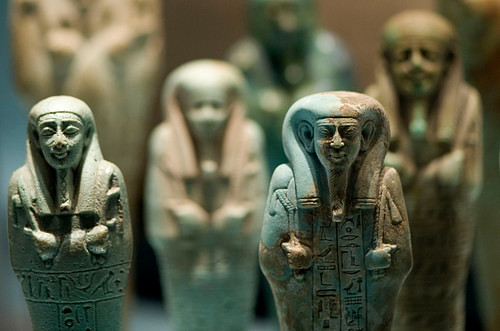
Shabti Dolls
Art would flourish during the Middle Kingdom of Egypt (2040-1782 BCE) which is generally considered the loftier point of Egyptian civilisation. Colossal bronze began during this catamenia every bit well as the great temple of Karnak at Thebes. The idealism of Old Kingdom depictions in statuary and paintings was replaced by realistic representations and the lower classes are likewise plant represented more often in art than previously. The Middle Kingdom gave style to the Second Intermediate Menses of Egypt (c. 1782 - c. 1570 BCE) during which the Hyksos held large areas of the Delta region while the Nubians encroached from the due south. Art from this period produced at Thebes retains the characteristics of the Centre Kingdom while that of the Nubians and Hyksos - both of whom admired and copied Egyptian art - differs in size, quality, and technique.
New Kingdom fine art is defined by loftier quality in vision & technique due largely to Arab republic of egypt'southward interaction with neighboring Cultures.
The New Kingdom (c. 1570 - c. 1069 BCE), which followed, is the best-known period from Egypt'southward history and produced some of the finest and near famous works of art. The bust of Nefertiti and the golden death mask of Tutankhamun both come from this era. New Kingdom fine art is defined by high quality in vision and technique due largely to Arab republic of egypt'south interaction with neighboring cultures. This was the era of Arab republic of egypt's empire and the metallic-working techniques of the Hittites - who were now considered allies if not equals - greatly influenced the production of funerary artifacts, weaponry, and other artwork.
Post-obit the New Kingdom, the Third Intermediate Period (c. 1069-525 BCE) and Late Flow of Aboriginal Egypt (525-332 BCE) attempted with more or less success to continue the high standard of New Kingdom art while also evoking Onetime Kingdom styles in an endeavor to recapture the declining stature of Egypt. Persian influence in the Tardily Period is replaced by Greek tastes during the Ptolemaic Dynasty (323-xxx BCE) which besides tries to advise the Old Kingdom standards with New Kingdom technique and this paradigm persists into Roman Egypt (30 BCE - 646 CE) and the cease of Egyptian culture.
Types of Art, Detail, & Symbol
Throughout all these eras, the types of fine art were as numerous every bit human need, the resources to make them, and the ability to pay for them. The wealthy of Egypt had ornate paw mirrors, cosmetic cases and jars, jewelry, decorated scabbards for knives and swords, intricate bows, sandals, furniture, chariots, gardens, and tombs. Every aspect of any of these creations had symbolic significant. In the same way the balderdash motif on the Narmer Palette symbolized the ability of the male monarch, so every image, blueprint, ornamentation, or detail meant something relating to its possessor.
Among the most obvious examples of this is the golden throne of Tutankhamun (c. 1336-c.1327 BCE) which depicts the young king with his married woman Ankhsenamun. The couple is represented in a tranquillity domestic moment as the queen is rubbing ointment onto her husband'southward arm as he sits in a chair. Their close human relationship is established by the colour of their skin, which is the same. Men are unremarkably depicted with reddish skin because they spent more time outdoors while a lighter color was used for women's skin as they were more apt to stay out of the lord's day. This difference in the shade of pare tones did not represent equality or inequality but was simply an attempt at realism.
In the case of Tutankhamun's throne, however, the technique is used to express an of import attribute of the couple'due south relationship. Other inscriptions and artwork make articulate that they spent most of their time together and the artist expresses this through their shared peel tones; Ankhesenamun is but every bit sun-tanned equally Tutankhamun. The red used in this limerick also represents vitality and the energy of their human relationship. The couple's hair is bluish, symbolizing fertility, life, and rebirth while their clothing is white, representing purity. The background is gold, the colour of the gods, and all of the intricate details, including the crowns the figures wearable and their colors, all have their own specific meaning and get to tell the story of the featured couple.
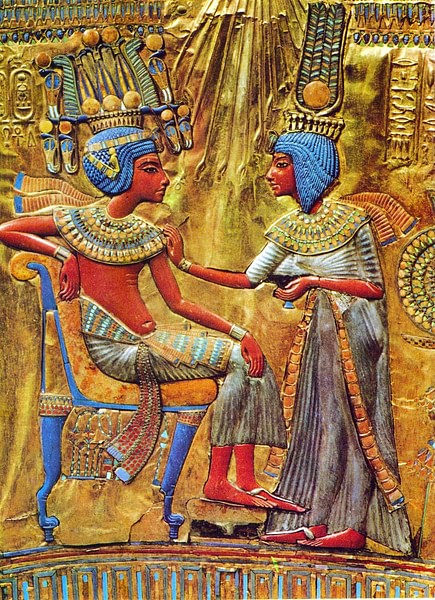
Tutankhamun & Ankhsenamun
A sword or a cosmetic example was designed and created with this aforementioned goal in mind: story-telling. Fifty-fifty the garden of a house told a story: in the centre was a pool surrounded past trees, plants, and flowers which, in turn, were surrounded by a wall and one entered the garden from the house through a portico of decorated columns. All of these would have been arranged carefully to tell a tale which was meaning to the possessor. Although Egyptian gardens are long gone, models made of them as grave goods have been institute which testify the slap-up care which went into laying them out in narrative form.
In the case of the noble Meket-Ra of the 11th Dynasty, the garden was designed to tell the story of the journey of life to paradise. The columns of the portico were shaped like lotus blossoms, symbolizing his habitation in Upper Arab republic of egypt, the pool in the center represented Lily Lake which the soul would have to cross to accomplish paradise, and the far garden wall was busy with scenes from the afterlife. Every fourth dimension Meket-Ra would sit in his garden he would be reminded of the nature of life as an eternal journeying and this would nigh probable lend him perspective on whatever circumstances might be troubling at the moment.
Techniques
The paintings on Meket-Ra's walls would have been done by artists mixing colors made from naturally occurring minerals. Blackness was made from carbon, red and yellow from iron oxides, bluish and green from azurite and malachite, white from gypsum and so on. The minerals would be mixed with crushed organic cloth to different consistencies and and so farther mixed with an unknown substance (possibly egg whites) to make information technology viscous so it would attach to a surface. Egyptian pigment was so durable that many works, fifty-fifty those not protected in tombs, have remained vibrant afterwards over four,000 years.
Although home, garden, and palace walls were usually decorated with flat two-dimensional paintings, tomb, temple, and monument walls employed reliefs. There were high reliefs (in which the figures stand up out from the wall) and low reliefs (where the images are carved into the wall). To create these, the surface of the wall would be smoothed with plaster which was then sanded. An artist would create a piece of work in minature and and so depict grid lines on it and this filigree would then be drawn on the wall. Using the smaller piece of work as a model, the artist would be able to replicate the image in the correct proportions on the wall. The scene would kickoff be drawn and then outlined in ruby-red pigment. Corrections to the work would be noted, possibly past another artist or supervisor, in black paint and once these were taken intendance of the scene was carved and painted.
Paint was likewise used on statues which were made of wood, stone, or metal. Stonework first developed in the Early on Dynastic Menstruum in Arab republic of egypt and became more and more refined over the centuries. A sculptor would work from a unmarried block of rock with a copper chisel, wooden mallet, and finer tools for details. The statue would then be smoothed with a rubbing material. The stone for a statue was selected, equally with everything else in Egyptian art, to tell its own story. A statue of Osiris, for case, would be made of black schist to symbolize fertility and rebirth, both associated with this particular god.
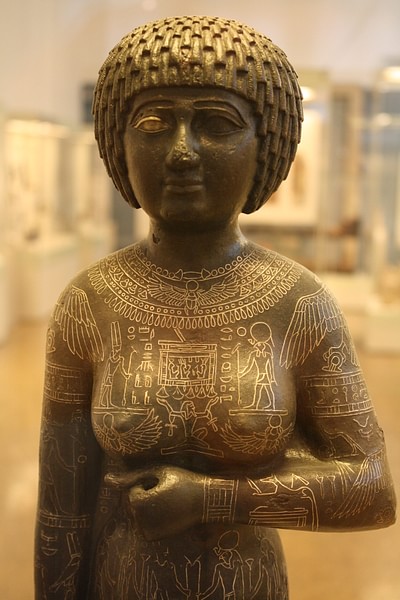
Egyptian Priestess Takushit
Metallic statues were usually small and made of copper, bronze, silver, and gold. Gilt was particularly popular for amulets and shrine figures of the gods since it was believed that the gods had golden peel. These figures were made past casting or sail metal work over wood. Wooden statues were carved from different pieces of copse and then glued or pegged together. Statues of wood are rare but a number have been preserved and show tremendous skill.
Cosmetic chests, coffins, model boats, and toys were made in this same way. Jewelry was commonly fashioned using the technique known equally cloisonne in which thin strips of metal are inlaid on the surface of the work and then fired in a kiln to forge them together and create compartments which are so detailed with jewels or painted scenes. Amid the all-time examples of cloisonne jewelry is the Eye Kingdom pendant given by Senusret Ii (c. 1897-1878 BCE) to his daughter. This work is fashioned of thin gold wires attached to a solid golden bankroll inlaid with 372 semi-precious stones. Cloisonne was also used in making pectorals for the king, crowns, headdresses, swords, ceremonial daggers, and sarcophagi among other items.
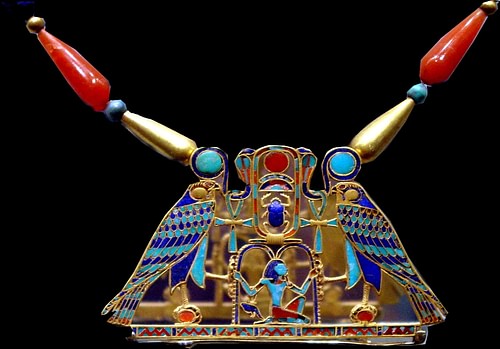
Pectoral of Senusret 2
Conclusion
Although Egyptian art is famously admired it has come under criticism for being unrefined. Critics claim that the Egyptians never seem to have mastered perspective as there is no interplay of light and shadow in the compositions, they are always 2 dimensional, and the figures are emotionless. Statuary depicting couples, information technology is argued, testify no emotion in the faces and the aforementioned holds truthful for boxing scenes or statues of a rex or queen.
These criticisms neglect to recognize the functionality of Egyptian fine art. The Egyptians understood that emotional states are transitory; 1 is non consistently happy, sad, aroused, content throughout a given day much less eternally. Artworks present people and deities formally without expression because it was thought the person's spirit would need that representation in lodge to alive on in the afterlife. A person'southward proper name and image had to survive in some class on world in society for the soul to keep its journeying. This was the reason for mummification and the elaborate Egyptian burying rituals: the spirit needed a 'buoy' of sorts to return to when visiting earth for sustenance in the tomb.
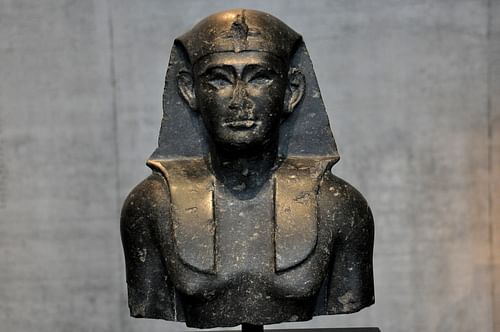
Egyptianized Statue of Augustus
The spirit might not recognize a statue of an angry or jubilant version of themselves just would recognize their staid, complacent, features. The lack of emotion has to do with the eternal purpose of the piece of work. Statues were made to be viewed from the front, usually with their backs confronting a wall, and then that the soul would recognize their sometime selves easily and this was as well truthful of gods and goddesses who were thought to alive in their statues.
Life was but a modest part of an eternal journeying to the ancient Egyptians and their art reflects this belief. A statue or a cosmetics case, a wall painting or amulet, whatever form the artwork took, information technology was made to last far across its owner's life and, more importantly, tell that person's story as well as reflecting Egyptian values and beliefs every bit a whole. Egyptian fine art has served this purpose well as it has continued to tell its tale at present for thousands of years.
This article has been reviewed for accuracy, reliability and adherence to bookish standards prior to publication.
Source: https://www.worldhistory.org/Egyptian_Art/